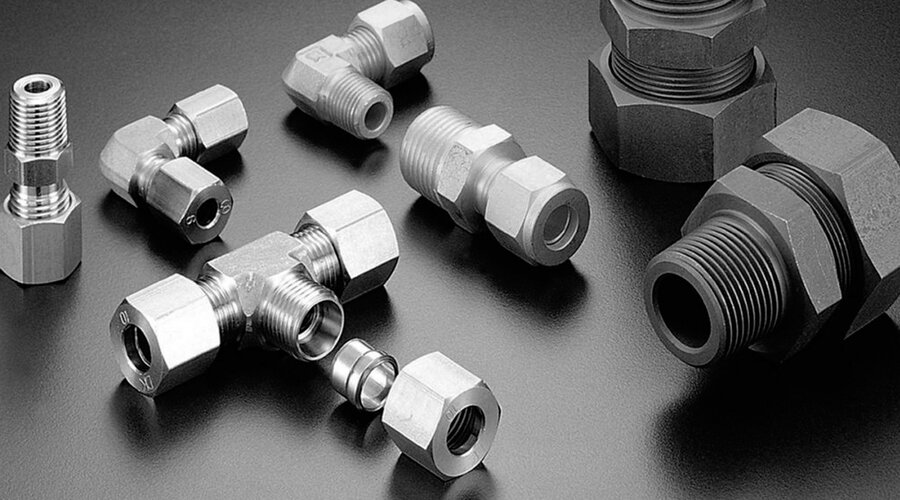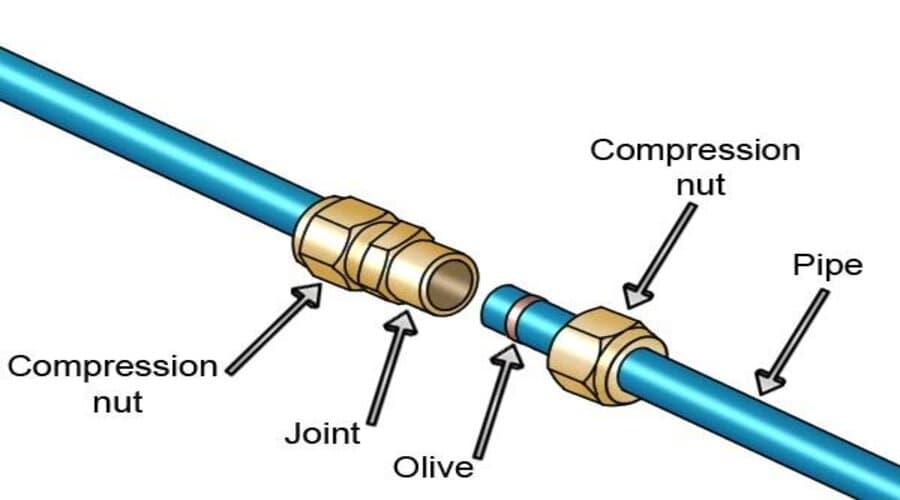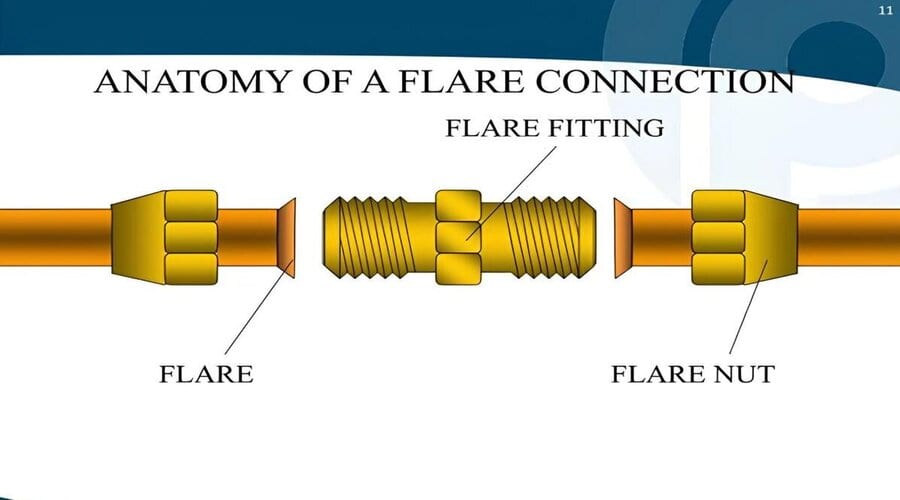Flare and compression fittings are vital in many piping systems because they create a strong seal. These types of fittings are crucial for plumbing systems. These link various pipelines and components.
In the domain of copper pipe connection, two prevalent types of fittings are flare fittings and compression fittings. In flare vs compression fitting, we will discuss distinct designs and applications. The resistance of flare fittings to high pressure is notable. However, the compression fittings are simple to install.
What is a Flare Fitting?

A type of compression fitting, flare fittings are used to make pressure- and leak-resistant seals. It secures the tapering end of the flared pipe with a flare nut. Flare fittings are compatible with aluminum, flexible (or soft) copper, and mild steel. The expansion of the tube does not need heat.
In areas that are hard to access, use flared fittings. Its durability is well-known.
What Is a Compression Fitting?

Compression fittings create a secure seal by pushing one part into another with tubing. However, the water treatment industry has executed quick-connect fittings. But, compression fittings remain effective. It provides a secure, firm seal regardless of their reduced use.
The sleeves, nuts, and fitting body are the parts of the compression fitting body. The flare nut fits the sleeve into the fitting body, where it functions as the seal. Understanding their distinctions is vital to choosing the most suitable for application.
Flare Vs Compression Fitting: What Is the Difference?

Before making a selection, remember the following different points:
- Temperature and pressure requirements:
Compression fittings are more suitable for moderate pressures. However, flared fittings are ideal for high-pressure situations.
- Maintenance and installation:
For fixes or changes, compression fittings are easy to assemble and disconnect. Flare fittings are more labor-intensive. Moreover, it needs less upkeep in the long run.
Installation needs more effort, but flare fittings do not need as much maintenance in the long run.
- Connecting material:
Flare fittings need copper or another soft-enough tube material.
- Designs:
Flare and compression fittings use nuts to secure the connection. These fittings prevent leaks, although they have different designs.
- Compression fittings design
The nut, ferrule or ring, and body constitute the components of a compression fitting. The ferrule secures the tube in alignment as it is inserted into the body of the fitting.
The ferrule compresses between the nut and the body. It forms a seal as the nut tightens. Water, gas, and hydraulic systems use compression fittings. It is well-known for its simplicity of assembly and disassembly.

- Flare fittings design
Flare fittings use flare copper tubing as part, where the pipe flare end expands conical. Over the tubing is a nut and a conical surface that matches the fitting.
Press the extending end of the tubing against the fitting end. Tighten the nut to achieve a tight seal. This kind of linkage can endure high temperatures and pressure. It rendering for gas and high-pressure applications.
Compression fittings applications
The simplicity of installation and upkeep influences the selection of compression fittings. They are the best choice for applications involving lower pressures. The system needs regular disassembly and reassembly.
- Water plumbing systems:
Compression couplings are easy to install and don’t need special equipment. Homes and businesses use them for water plumbing systems. People use it in sinks, toilets, and other fixtures.
- Automation system:
Compression couplers aid in the assembly and disassembly of precise measurement and control systems. Manufacturing or laboratory settings have these systems. Compression couplers prove particularly useful when one needs to make adjustments or corrections.
- Pneumatic systems:
Compression fittings are effective in compressed air systems. Pneumatic tools or air supply lines are used at high pressures. They use them to create tight seals.
- Low-pressure gas applications:
The natural gas line also uses compression fittings, which are suitable for gas applications with low pressures. Portable gas heaters or some household appliances contain these.
- Hot and cold water supply lines:
Compression fittings are simple and easy to install. This is why numerous hot and cold water supply pipes for faucets, toilets, and appliances utilize them. Correct in tight areas where a flare tool would not work well.
- Flare fittings applications
Generally, people use flare fittings for thermal expansion, contraction, and high pressure. They offer a resilient seal capable of withstanding these severe conditions.
- High-pressure gas lines:
Manufacturers make flare fittings for natural gas or propane gas lines. It can handle high pressures without leaking.
- Refrigeration systems:
Can you use flare fittings for water? HVAC and refrigeration systems use flare connectors to join parts. They need to handle refrigerant pressure and temperature changes without breaking.
- Vehicle braking systems:
Automobile brake lines use flare fittings. They create a solid and leak-proof connection. This connection can handle the high pressure of hydraulic fluid.
- Hydraulic systems:
Flare fitting adapter for safe connection in high-pressure fluid transfer in hydraulic systems and heavy machinery.
Aerospace uses flare fittings for fuel, oil, and hydraulic lines. They can handle harsh flight conditions like temperature and pressure changes.
Flare versus Compression Fittings: Selection Criteria
Fluid type:
Both compression fittings have versatility. These are used with hydraulic, gas, and water systems. Testing the fitting’s compatibility with a particular fluid type is essential. It prevents any potential leakage or deterioration of the material.
Pressure and temperature:
Flare fittings are better for high pressure and temperature. They have metal-to-metal contact for a more robust seal.
Ease of assembly:
Compression connections provide a helpful solution for systems that need frequent disassembly. Their assembly does not require specific tools, and they can be disconnected and disconnected.
Pipe or tube material:
Materials used to construct the pipes or tubes are crucial. Copper-flared fittings or aluminum are more accessible pipe materials that allow flare fittings. Compression fittings can be used when it is impossible to flare the pipe material.
How to Use a Flare Fitting?

Remember that flare fittings are only compatible with flexible flared copper pipes, not rigid ones. Flare fittings, in comparison to compression fittings, require the use of a flaring copper tool.
By “flaring” the ends of the copper pipe, this two-piece tool modifies it to fit a flare fitting. Form the flared connection before cutting the tubing to length, as the tubing can separate during the flare.
Two adjustable wrenches and a flaring tool are required to get started. Almost 30 minutes are needed to fit three parts into a union if you have experience with flaring tools. Expect it to take longer, if not, as you will be learning how to use these flaring copper tools.
- Flare the tubing ends.
- Before you flare the end of the tube, make sure you put on the flare nut.
- Select an opening in the flaring block whose external diameter corresponds to flexible copper pipes.
- Secure the tool to the pipes using a clamp.
- Tighten the fitting and align the compression cone on the end of the tubing.
- The cone flares at the end of the tubing as the handle rotates.
- Once you pull the tubing from the block, examine your work.
- Repeat the procedure after removing the flared part if the end has divided.
You need a flaring tool for the initial process, but do you know what is a tool for flaring? Joining or securing copper flared fittings fabricates a flare joint by pressure. This enables the joining of tubes.
- Assemble the pieces
- Position the flare union in contrast to one of the tubing’s flared ends.
- At this point, lower the nut and hand-tighten it.
- Perform the same action on the other side.
This is a straightforward step requiring only a connection and change. Contrary to common opinion, you do not need a pipe joint compound for this undertaking.
- Tighten and test
- Secure a nut with one wrench and the union with the other.
- You should avoid overtightening a joint.
- Once snug, give each nut a half-turn.
- To test, turn on the water.
- Tighten the flare joint with care until the discharge stops to appear.
Analyze the joint to determine the tubing cut if the discharge continues to occur. Confirm that the fitting did not have the nut cross-threaded. To conclude, Anchor or support the tubing with two feet of space on either side of the flare fitting. These should either halt the flow.
Employing two wrenches when performing the union tightening process is critical. One should maintain stillness while the other tightens the pipe to stabilize it. Take care in this entire process.
FAQs
Is flare fitting better than compression fitting?
Plumbing requires both flare and compression fittings. However, flare fittings provide a more potent and watertight seal.
What is the pressure capacity of flare fittings?
Based on their design, the maximum pressure that flare fittings can endure is 346 bar (5,000 psi).
What is the advantage of flare fittings?
The metal-to-metal connection of flare fittings provides increased resistance to pressure and temperature.
Do flare or compression fittings need soldering?
No. You do not need to solder for flare and compression fittings.
Final Thought for Flare Fitting Vs Compression Fittings
Compression vs flare fittings are the preferred choice when connecting tubing sections, which becomes difficult through other methods like sweating. Flared and compression fittings are necessary for plumbing work. Moreover, it provides a more reliable and secure seal.
